Last issue of Hulk ended with Jennifer Walters being crushed by Maise Brewn’s shadow gooey fear monster. It seemed the only way for Jen to escape was to transform into the Hulk again, something she’s been dreading since the start of the Deconstructed story arc. In the sixth and final part of Deconstructed, Jen has to face fears and reconnect with her identity as the She-Hulk.
Fear itself (quite literally)
We open Hulk #6 with a light scene between Jen and her cousin Bruce Banner, making clear how much they love and care about each other. Over the course of the Deconstructed arc, the series has constantly reminded us how much Bruce was directly tied not only to Jennifer as a person, but to her identity as the She-Hulk as well. This scene is no different, and the path for Jen to reclaim her identity of She-Hulk intersects with her trauma and grief over Bruce’s death.
Jennifer’s inner monologue during the scene states that one of her biggest fears was for something bad to happen with someone she loves. As a superhero, that seemed both a distant possibility and a very real one. She always tried to ignore those fears…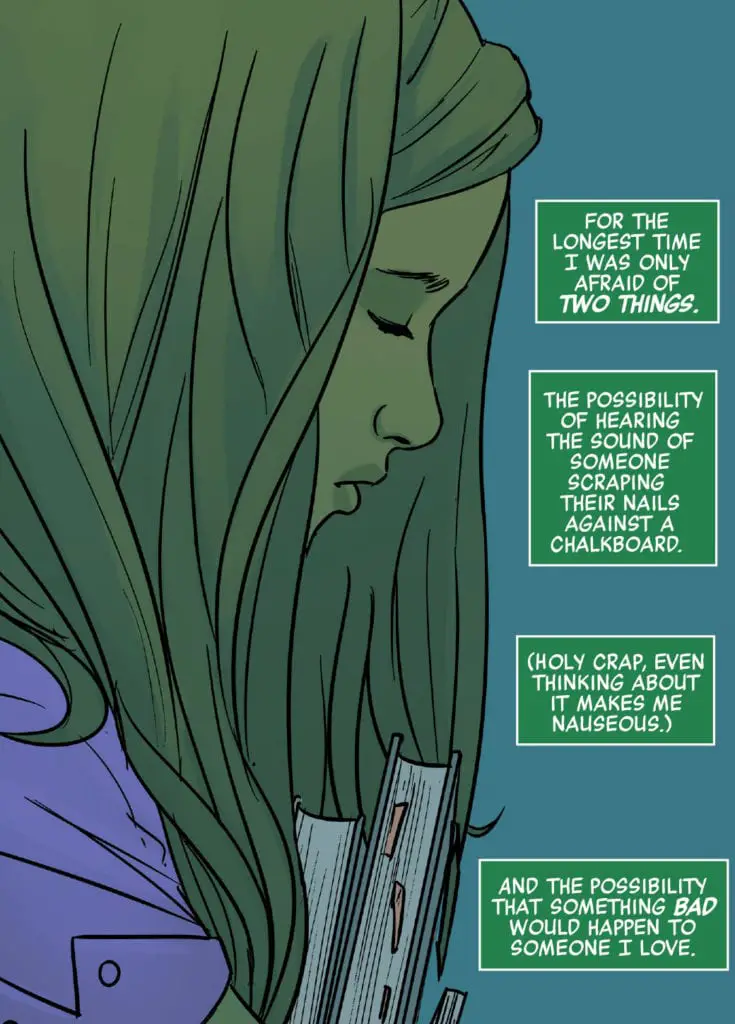
…but she’s currently fighting a shadow gooey monster that is the embodiment of fear, so that kind of thought sort of pops into one’s head.
In fact, the whole apartment building is now surrounded by a dome-like structure made of monster parts, isolating Jen and the building residents from the outside, but also attracting a lot of attention.
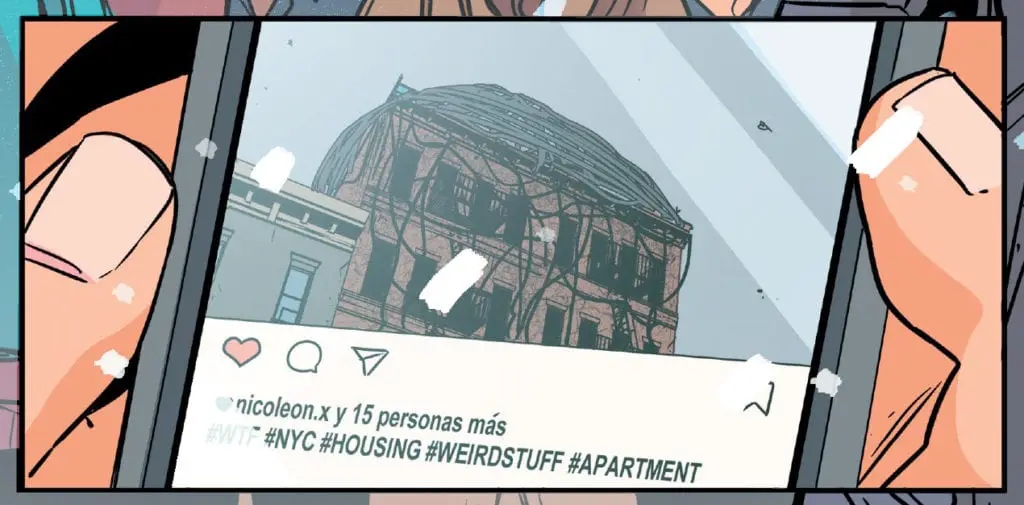
Jen is covered by a blob-like portion of the monster, because Maise is still convinced that finishing her lawyer will keep herself and the other residents safe.
Now, the Hulk is usually associated with anger, but the whole Deconstructed arc builds a close association with a different feeling too: fear. Jennifer’s PTSD comes from one of her worst fears coming true. The PTSD brings its own set of new fears, including a fear of transforming into the green monster she was so comfortable being before. The embodiment of Maise’s and the other residents’ fears took this situation to superhero intervention-levels, and now both her fears and the Fear Monster bring the Hulk back in the game.
Yes, after struggling so much with her Hulk identity, Jen finally becomes She-Hulk again. Not just any Hulk: a grey, monstrous, and more violent version of her She-Hulk self. No wonder she was scared. But more on that in a moment.
Now in possession of her super strength, She-Hulk can kick the Fear Monster, under protests of Maise’s buddies, who had no idea she was a Hulk. It’s the best of both worlds: superhero punches monster plus an ongoing exploration of trauma and fears. I’m a fan of both approaches, so keep them coming.
Last time I mentioned that Maise’s determination in having Jen killed felt a little sudden to me. I stand by that feeling, but this time we have a better understanding of Maise’s perspective when she confronts Jen. We see how desperate she is, with the feeling of abandonment and losing what little hope she found in Jen on top of everything else she’s been through. What better diet to feed a Fear Monster? In the end, I feel sorry for her.
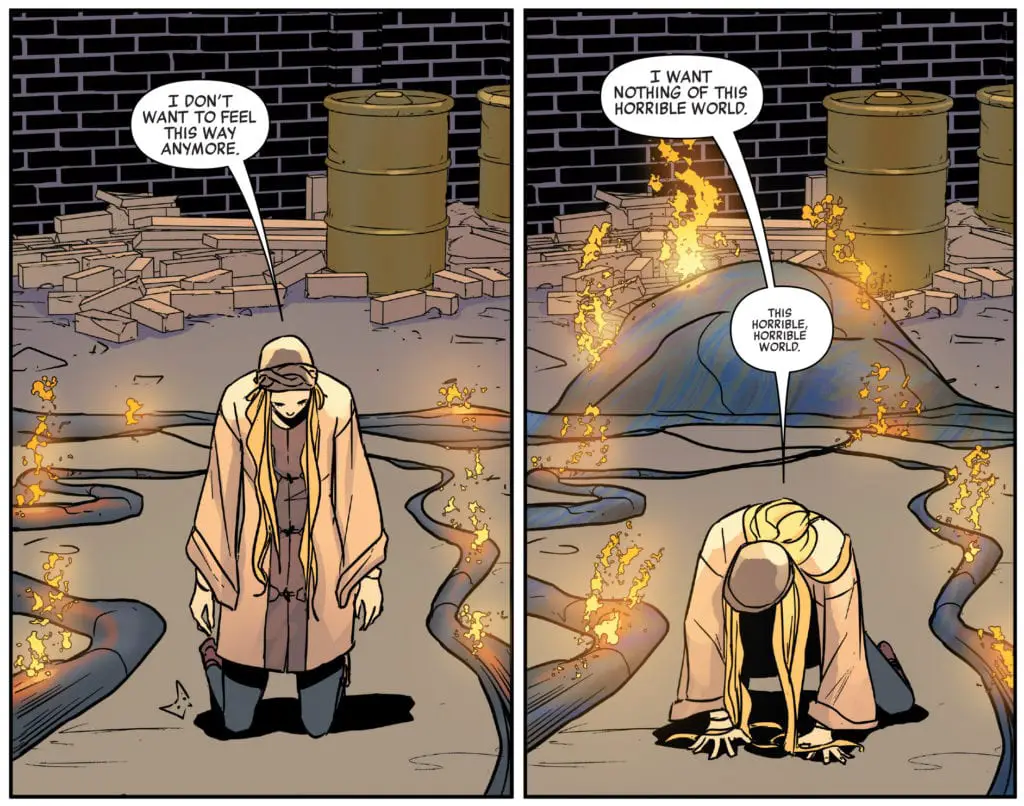
Maise’s despair reaches its peak and she decides to destroy herself instead of destroying Jen. Despite her bestial new form, the Hulk still maintains some if not most of her intellect and a good portion of her heart, trying her best to save Maise. There’s a big explosion caused by Maise’s attempts to burn the building, but the Hulk manages to save her. Not sure what happened to the other residents, but I assume they’re okay?
Maise is taken to the hospital again, with minor injuries. I feel really sorry for her and I hope this isn’t the last we see of the inhuman; her story and her own trauma were an integral part of Deconstructed, and she’s in a very fragile situation right now. Though, as Jen points, she’ll need a different lawyer.
One week later, Jen attends a celebration of Bruce Banner’s work. She doesn’t look especially happy, but simply being there means a lot and shows a different Jennifer than the one we’ve been seeing so far. Flo is there too, I was wondering what happened to her. Jen is not hostile towards Flo, which is another hint that something changed for the She-Hulk.
The ending doesn’t strike me as happy, but it’s definitely positive. The confrontation with Maise and her Fear Monster put Jen a step closer to recovery, allowing her to regain a little bit of her identity. As she says herself, she’s a different monster now. But still a monster fighting the good fight.
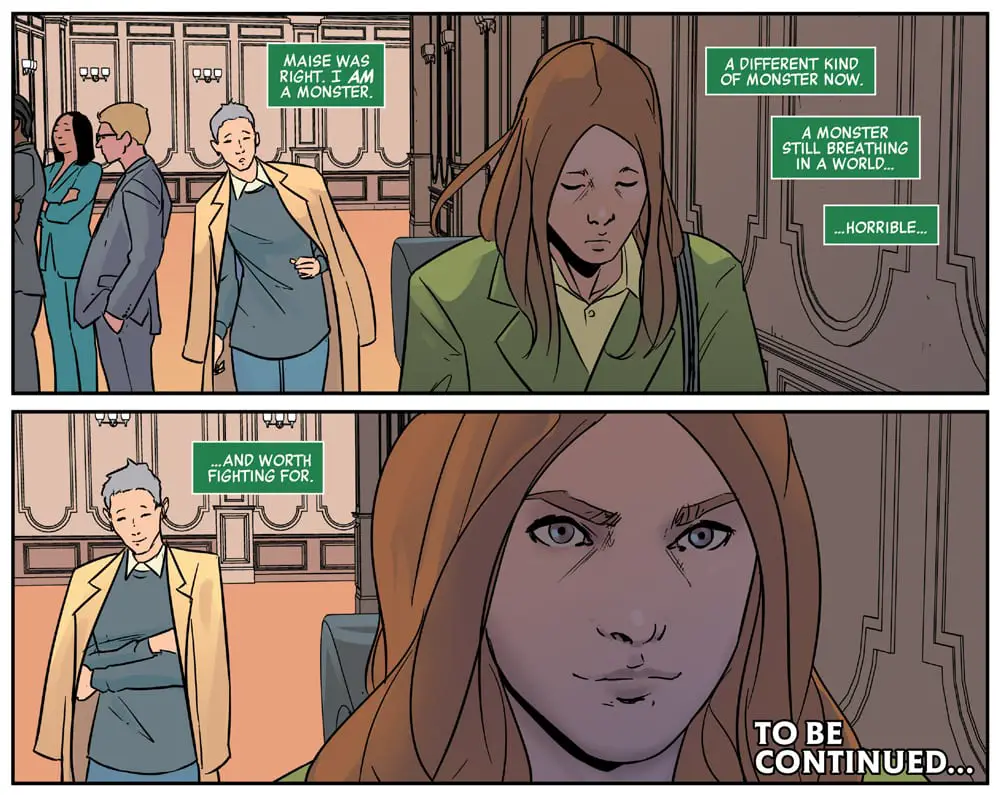
The old Hulk and the new
I’m a fan of the Nico Leon’s art and Matt Milla’s colors. Over the course of Deconstructed they were vital in setting the tone of Jennifer’s journey and feelings, with detail and carefulness, exploring the sort of visual storytelling that only the comic book medium allows.
A great example of this is the contrast between the old She-Hulk and the current one. I love the new design, because through visuals alone the entire team of creators conveys that we’re in front of a very different hero. The old She-Hulk was very similar to her Jennifer Walters self, green skin aside:
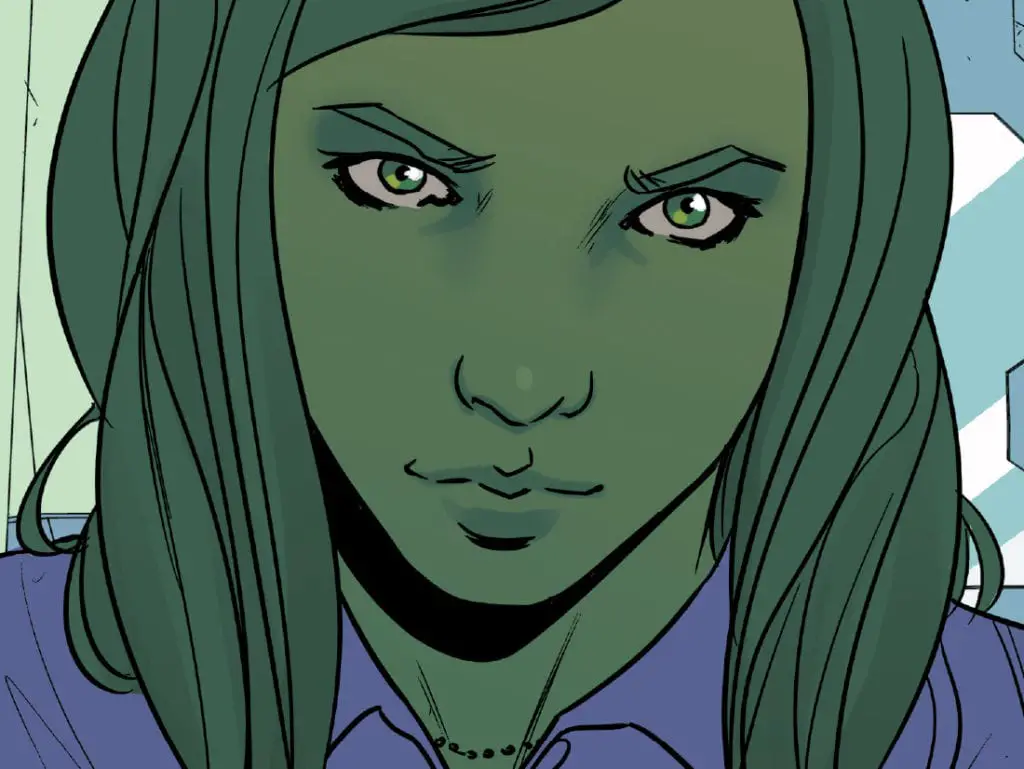
She seems civilized, almost delicate, not what you would call a monster. This new Hulk, however, is very much a monster. Her grey-with-radioactive-green-stripes coloring, her ragged clothes, her bursting muscles, her dehumanized face, her animalesque gestures, the fragmented dialogue… It all feels more bestial, more unnatural, like a more raw version of the Hulk. I would freak out if that was my lawyer, just saying.
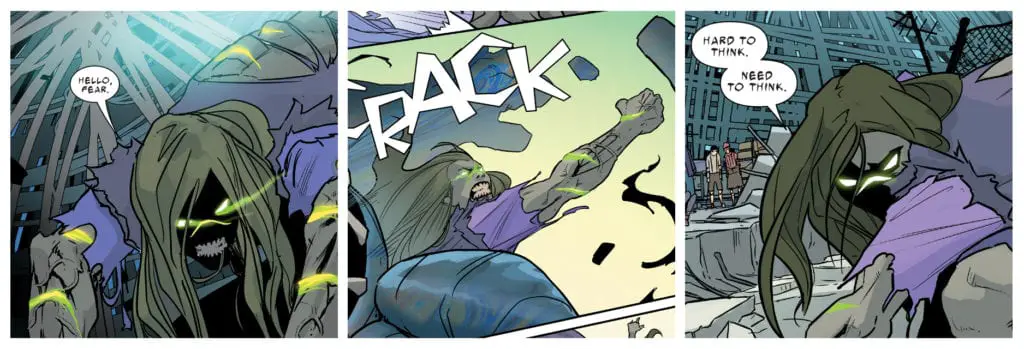
The art works in tune with the story, visually highlighting the feelings and themes the narrative is exploring. Look no further than this visual parallel between Jennifer and Maise:
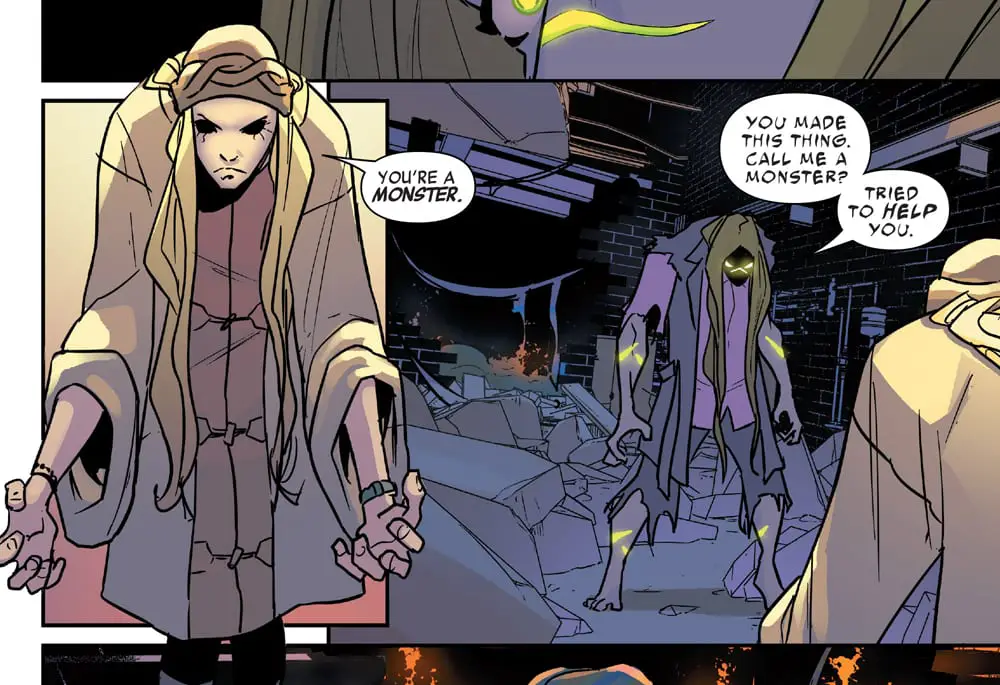
Closing thoughts
This issue marks the end of the Deconstructed arc, so I have to consider it both on its own and as the conclusion of a character arc. This arc was also my introduction to She-Hulk as a comic book character, since I wasn’t familiar with her stories when I started reviewing this title. It may not the best starting point because Jennifer is struggling with an unusual situation and veteran comic book readers probably miss her old self, but I’m still happy with my choice of beginning.
It’s rare to see stories that properly explore trauma and PTSD, and Hulk took its time to examine the consequences of Jennifer’s experiences, actions, and feelings. Maise was a great choice of antagonist, being a foil to Jen, a Jen-that-could-have-been if a few details were different. Sure, we have to draw the line somewhere and “gruesome murder spree by shadow gooey impersonation of fear” seems a good place as any. But Maise still feels more desperate than evil, and very real and relatable in her pain. Maise and her monster were an extension of Jennifer’s inner conflicts and the book balanced both aspects with grace.
To be honest I feared they would drop the ball at some point, going for a cheap resolution and returning Jennifer’s life to status quo. That, of course, didn’t happen. In this issue it’s clear that something is ending, that Jennifer is somewhere different now than she was before the arc started. But this is only the beginning and whatever story comes next will be built on top of the foundation laid by this one.
That’s kind of the thing, isn’t it? When something awful happens, something that traumatizes you, you don’t get to go back to who you were before, to how things were before. All you can do is try to move forward, to resignify your identity and your life in the process. I’m glad Hulk gave us that, a little bit of what dealing with trauma and PTSD truly means. I hope future stories can still incorporate this important part of Jennifer’s life, even if Bruce eventually returns.
I do wish we could have seen more of this new Hulk and what the transformation meant for Jennifer. We got an idea, yes, but becoming the Hulk again was something she was struggling with during the entire arc, so I feel there’s a lot more to explore than what we got. But there’s still time to do that, and I’m excited to see what new stories will bring.
Final score: 9/10
All images courtesy of Marvel Comics
Hulk (2016) #6 Credits
Writer: Mariko Tamaki
Artist: Nico Leon
Colors: Matt Milla
Letters: VC’s Cory Petit
Designer: Manny Mederos

